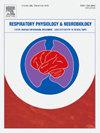大鼠脊髓损伤后横膈膜的化学发生激活。
IF 1.6
4区 医学
Q3 PHYSIOLOGY
引用次数: 0
摘要
我们验证了一个假设,即在脊髓损伤(SCI)后,激活颈中脊髓的DREADDs可以恢复自发性呼吸时膈肌的激活。成年Sprague Dawley大鼠(n = 7)接受双侧颈中腹角注射编码兴奋性DREADD (AAV9-hSyn-HA-hM3D(Gq)-mCherry)的AAV结构;滴度:2.44×1013 vg/mL)。随后记录异氟醚麻醉下自主呼吸时膈肌电图(EMG)的活动。选择性DREADD配体JHU37160 (J60)在颈椎C2节段颈椎偏斜后的急性(3天)、亚急性(2周)和慢性(2个月)时间点静脉注射。J60在所有时间点的膈肌肌电输出均显著增加,50%的试验中瘫痪的半膈肌肌电活动几乎完全恢复。脊髓完整大鼠(n = 8)对DREADD naïve给予J60后,膈肌活动没有增加。这些概念验证结果表明,该技术的改进可能为改善颈椎脊髓损伤后膈肌激活提供了一种策略。本文章由计算机程序翻译,如有差异,请以英文原文为准。
Chemogenetic activation of the diaphragm after spinal cord injury in rats
We tested the hypothesis that activation of DREADDs in the mid-cervical spinal cord could restore diaphragm activation during spontaneous breathing after cervical spinal cord injury (SCI). Adult Sprague Dawley rats (n = 7) received bilateral mid-cervical ventral horn injections of an AAV construct encoding an excitatory DREADD (AAV9-hSyn-HA-hM3D(Gq)-mCherry; titer: 2.44 × 1013 vg/mL). Subsequently, diaphragm electromyogram (EMG) activity was recorded during spontaneous breathing under isoflurane anesthesia. The selective DREADD ligand JHU37160 (J60) was administered intravenously at acute (3 days), sub-acute (2 weeks), and chronic (2 months) timepoints following cervical hemilesion at spinal level C2. J60 administration resulted in robust increases in diaphragm EMG output at all timepoints, and near-complete restoration of diaphragm EMG activity from the paralyzed hemi-diaphragm in 50 % of trials. Administration of J60 to DREADD naïve, spinal intact rats (n = 8) did not produce an increase in diaphragm activity. These proof-of-concept results indicate that refinement of this technique may provide a strategy for improving diaphragm activation after cervical SCI.
求助全文
通过发布文献求助,成功后即可免费获取论文全文。
去求助
来源期刊
CiteScore
4.80
自引率
8.70%
发文量
104
审稿时长
54 days
期刊介绍:
Respiratory Physiology & Neurobiology (RESPNB) publishes original articles and invited reviews concerning physiology and pathophysiology of respiration in its broadest sense.
Although a special focus is on topics in neurobiology, high quality papers in respiratory molecular and cellular biology are also welcome, as are high-quality papers in traditional areas, such as:
-Mechanics of breathing-
Gas exchange and acid-base balance-
Respiration at rest and exercise-
Respiration in unusual conditions, like high or low pressure or changes of temperature, low ambient oxygen-
Embryonic and adult respiration-
Comparative respiratory physiology.
Papers on clinical aspects, original methods, as well as theoretical papers are also considered as long as they foster the understanding of respiratory physiology and pathophysiology.

 求助内容:
求助内容: 应助结果提醒方式:
应助结果提醒方式:


